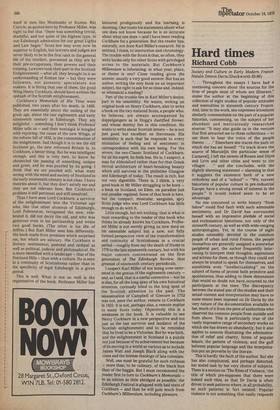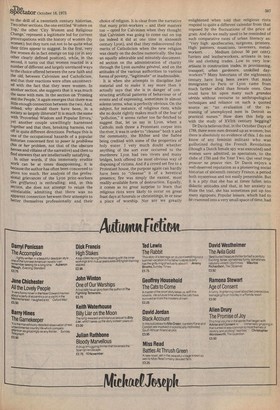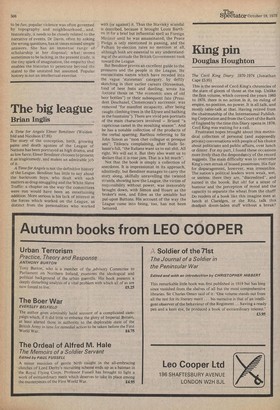Hard times
Richard Cobb
Society and Culture in Early Modern France Natalie Zemon Davis (Duckworth 0.80) ". . . Throughout the essays I have had a continuing concern about the sources for the lives of people most of whom are illiterate," states the author at the beginning of this collection of eight studies of popular attitudes and mentalities in sixteenth century France. And, later in the work, she expresses intentions similarly commendable on the part of a popular historian, commenting, on the subject of her abundant and meticulously researched sources: "It may also guide us in the venture that first attracted me to these collections — to use them to hear the voice of the people therein . . ." Elsewhere she traces the path on which she has set herself: "To track down the source of Misrule[in the particular sense of Carnaval], I left the streets of Rouen and Dijon and Lyon and other cities and went to the villages . . ." and she concludes, with the slightly alarming statement — alarming in that it suggests the existence both of a new orthodoxy and of a "school" — "We, current historians of popular culture in pre-industrial Europe, have a strong streak of interest in the people." It would indeed seem to be an advantage.
No one concerned to write history "from below" could find fault with such admirable sentiments; and Dr Davis has surrounded herself with an impressive pleitide of social and ecclesiastical historians, not only of the sixteenth century, as well as with wide-ranging anthropologists. Yet, in the course of eight studies ostensibly devoted to the common people of urban and rural France, the people themselves are generally assigned a somewhat peripheral part, the author frequently intervening to interpret their thoughts, aspirations and actions for them, as though they could not always be trusted to speak for themselves, and sometimes even "intellectualising" on the subject of forms of protest both primitive and spontaneous, thus adding to them dimensions that would no doubt not have occurred to the participants at the time. The discrepancy between the stated aim of the studies and their actual content and interpretation may have to some extent been imposed on Dr Davis by the very nature of the documentation available to her, much of it from the pens of authorities who observed the common people from outside and from above. This is particularly true of the vastly impressive range of secondary works on which she has drawn so abundantly; but it also applies to sources illustrating the administration of relief and charity, forms of popular leisure, the pattern of violence, and the gulf between popular language and the interpretation put on proverbs by the literate.
This is hardly the fault of the author. But she has also complicated, and perhaps distorted, her stated task by her very choice of subjects. There is a section on `The Rites of Violence,' the title of which pre-supposes that there were indeed such rites, so that Dr Davis is often driven to seek patterns where, in all probability, no such patterns in fact existed. Popular violence is not something that easily responds
to the drill of a twentieth century historian. Two other sections, the one entitled 'Women on Top,' the other 'City Women and Religious Change,' represent a legitimate bid for current preoccupations with the history of women (by women); but they turn out not to be quite what their titles appear to suggest. In the first, very few women do in fact emerge on top (or in any other clearly defined position), while, in the second, it turns out that women reacted in a number of different and largely unrelated ways to the choice offered between the new faith and the old, between Calvinism and Catholicism, and that their reactions were often unconnected with the fact that they were women. In another section, she suggests that it was much the same with men. In the section on 'Printing and the People,' it again emerges that there was little enough connection between the two. And, indeed, why should there have been, in a society so largely illiterate? It is much the same With 'Proverbial Wisdom and Popular Errors,' Yet another couple unwillingly harnessed together and that then, breaking harness, run off in quite different directions. Perhaps this is one of the occupational hazards of a popular historian concerned first to poser le prob/eme (his or her problem, not that of the obscure heroes and villains of the narrative) and then to find answers that are intellectually satisfying.
In other words, if this immensely erudite Work can be at times disappointing, it is because the author has often been concerned to Prove too much. Her analysis of the professional grievances of the Lyon print-workers (lea griffarins) is enthralling; and, in this section, she does not attempt to relate the unrelatable, admitting that there was no apparent connection between their attempts to better themselves professionally and their
choice of religion. It is clear from the narrative that many print-workers — and their masters too — opted for Calvinism when they thought that Calvinism was going to come out on top (as indeed it did at one time in sixteenth century Lyon), and that they rediscovered the merits of Catholicism when the new religion was clearly on the decline numerically. She has an equally admirable and minutely-documented section on the administration of charity through the Lyon aumone general, and on the attitudes of the various authorities to various forms of poverty, "legitimate" or inadmissible.
It is when she attempts to discipline her material and to make it say more than it actually says that she is in danger of constructing artificial patterns of behaviour or of events and of expressing, sometimes in almost solemn terms, what is perfectly obvious. On the subject, for instance, of religious riots, while she no doubt rightly makes much of the fear of "pollution," it seems rather too far-fetched to suggest that, let us say in Lyon, when a Catholic mob threw a Protestant corpse into the river, it was in order to "cleanse" both it and the community, the Rhone and the Saone being credited with some of the properties of holy water. I very much doubt whether anything of the sort ever occurred to the murderers: Lyon had two rivers and many bridges, both offered the most obvious way of disposing of victims. And if a crowd set fire to a Protestant house, the purpose again can hardly have been to "cleanse" it of a heretical presence; fire was simply the easiest, most readily-available form of destruction. Equally, it comes as no great surprise to learn that religious riots were likely to occur on great feast days at funerals or christenings, in or near a place of worship. Nor are we greatly
enlightened when told that religious riots respond to quite a different calendar from that imposed by the fluctuations of the price of grain. And do we really need to be reminded of such comparative rates of urban literacy as: "Very high: apothecaries, surgeons, printers. High: painters, musicians, taverners, metalworkers. . . . Medium (about 50 per cent): furriers and leatherworkers, artisans in textile and clothing trades. Low to very low: artisans in construction trades, in provisioning, transport; urban gardeners; unskilled dayworkers"? Many historians of the eighteenth century have long been aware that male immigrants to Paris or Lyon came from much farther afield than female ones. One could have hit upon many such grancies Writes without recourse to anthropological techniques and reliance on such a quoted source as: "an evaluation of the retraining of unemployed men in Detroit as practical nurses." How does this help us with the study of XVIth century begging?
Dr Davis believes that, in the October Days of 1789, there were men dressed up as worn en; but there is absolutely no evidence of this. I do not know of any feminist militant who was guillotined during the French Revolution (though a Dutch female spy was executed) and women were admitted, as spectators, to the clubs of 1793 and the Year Two. Qui veut trop prouver ne prouve riert. Dr Davis enjoys a well-deserved reputation as a pioneering social historian of sixteenth century France, a period both mysterious and not easily penetrable. But it is a pity that she has at times fallen into didactic attitudes and that, in her anxiety to blaze the trail, she has sometimes put up too many signposts. Popular leisure, which had to be crammed into a very small space of time, had
to be fun; popular violence was often governed by topography and neighbourhood„ and, historically, it needs to be closely related to the narrative of events. Dr Davis, often by asking the wrong questions, has at times missed simple answers. She has an immense range of scholarship at her disposal; what seems sometimes to be lacking, in the present study, is the tiny spark of imagination, the empathy that enables the historian to penetrate beyond the stated to the unstated but assumed. Popular history is not an intellectual exercise.




































 Previous page
Previous page